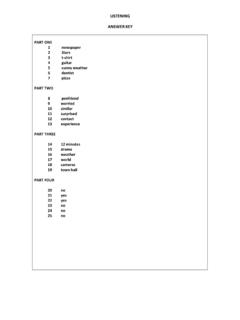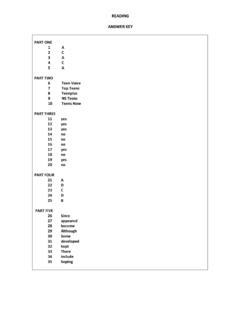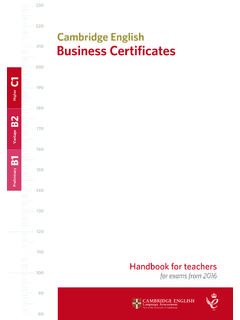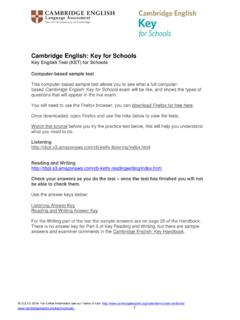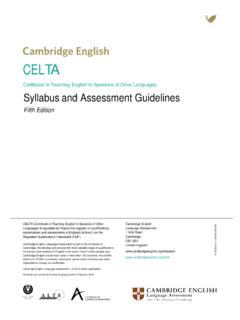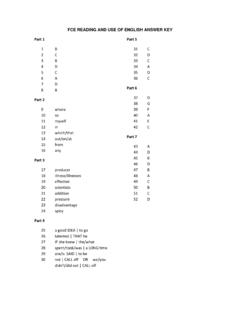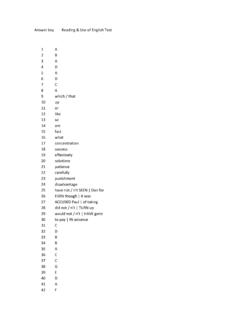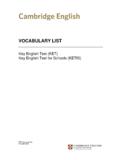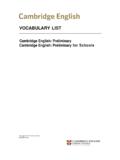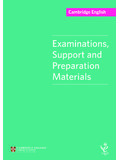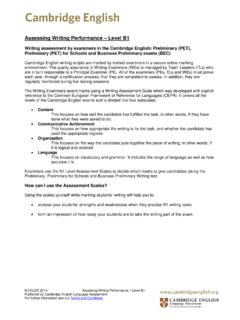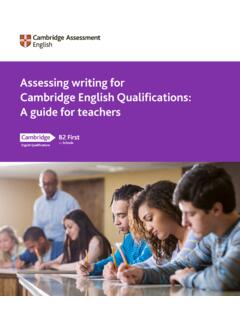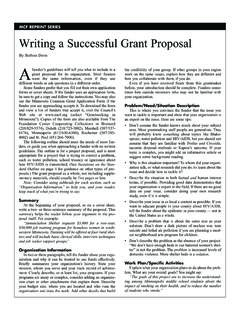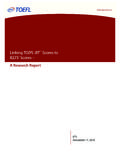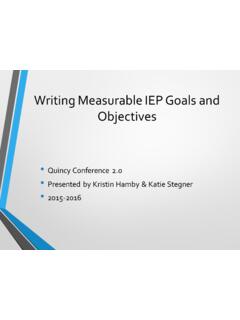Transcription of Comparing scores to IELTS - Cambridge English
1 Comparing scores to IELTS . B2 First and C1 Advanced Comparing scores to IELTS . B2 First is targeted at Level B2 on the Common European Framework of Reference (CEFR)*. This qualification demonstrates that candidates have the language skills to live and work independently in an English -speaking country or study on courses taught in English at pre-degree level. C1 Advanced is targeted at Level C1 on the CEFR. It is an in-depth qualification which shows that candidates have the high-level English language skills needed to study in English at undergraduate or postgraduate level, and to work and live in an English -speaking environment. Multilevel Tests Common European Cambridge Framework of English General and Reference (CEFR) Scale Schools higher education Business 230. 220. C2 210 C2 Proficiency C2 Proficiency PROFICIENT. BULATS 90 200. C1 190 C1 Advanced C1 Advanced C1 Business Higher 75. 180 Linguaskill B2 B2 First B2 First B2 Business INDEPENDENT. 170 for Schools Vantage 90. 160. 60.
2 Each Cambridge English B1 150 B1 Preliminary B1 Preliminary B1 Business Qualification is focused on for Schools Preliminary 40 a specific CEFR level. 140. A2 Key for Schools A2 130 A2 Key For exams from A2 Key to L e a r n e r s A2. Flyers C2 Proficiency, including Business, BASIC. 20. 120. we also report achievement above A1 110 A1 Movers and below target level. Y o u n g 100. Pre For Young Learners, we report A1. Pre A1. 90. Starters achievement at the target level 80. and the level below. B2 First and C1 Advanced both report on the IELTS Cambridge English Cambridge English Scale, a single range of scores used band score Scale score to report results for Cambridge English Qualifications, as shown in the diagram above. 191. Many institutions need to know how Cambridge 185. English Scale scores achieved in B2 First and C1 Advanced compare with IELTS ** band scores . 176. The table opposite shows this relationship. 169. 162. 154. * F urther information about the Common European Framework of Reference (CEFR) can be found at ** I ELTS is jointly owned by British Council, IDP: IELTS Australia and Cambridge Assessment English .
3 2. Using B2 First and C1 Advanced scores Every successful B2 First and C1 Advanced candidate receives a Statement of Results, which contains the following information: 1. score their overall score on the Cambridge English Scale. 2. Candidate profile their score on the Cambridge English Scale for each of the four skills (reading, writing , listening and speaking) and for Use of English . 3. Grade relates to the score and is a letter grade from A to C. 4. Candidates also receive an overall level on the CEFR. Candidates who have secured scores between 160 and 172 on B2 First are awarded grade C on that exam and are placed at Level B2 on the CEFR. Candidates who have secured a C1 Advanced grade C, having scored between 180 and 192 on the Cambridge English Scale, are at Level C1 of the CEFR and can be expected to be comparable in ability with candidates who have secured or in IELTS . Candidates who have secured scores between 180 and 190 in B2 First are awarded a grade A for that exam. They are also placed at Level C1 of the CEFR.
4 However, the breadth of coverage of B2 First at this level is limited and very careful consideration would be needed before accepting scores on B2. First as comparable to IELTS scores of Candidates who have secured scores of 160 to 179 on C1 Advanced are placed at Level B2 and may be expected to be comparable to candidates who have secured or in IELTS . Where institutions have specified a minimum IELTS requirement of , reference may be made to the Scale score , and a minimum requirement of 162 specified on either exam. If, say, the requirement is band overall but with a minimum score of in any skill, then an overall score of 169 may be specified with minimum scores of 162. in Listening, Reading, writing and Speaking. Where an overall requirement of IELTS band has been set, then a score of 185 should be specified, but as explained above, it may be appropriate to specify that the score has been obtained on C1 Advanced rather than B2 First. Example requirements IELTS requirements Cambridge English requirements Overall Cambridge English Scale score of 162, Overall IELTS band score achievable in B2 First or C1 Advanced.
5 Overall IELTS band score Overall Cambridge English Scale score of 176 from No less than in any skill C1 Advanced. No less than 169 in any paper. Cambridge Assessment English Comparing scores to IELTS 3. How we compared B2 First scores , C1 Advanced scores and IELTS performances We are responsible for the production of Cambridge English Qualifications and IELTS . All our qualifications and tests are built to a common underlying scale. Rasch analysis (Rasch 1960, 1980) is used to assess the relative difficulty of every Reading or Listening item, placing each on a common scale, regardless of the exam for which they are intended (Jones 2001). All items are kept in a database with information about their measurement characteristics. This permits the creation of multiple versions of an exam to a specific level and range of difficulty, and establishes the relationship between different exams. We have also published Common Scales for writing and Speaking, based on qualitative analysis of the features of these skills at different levels (Hawkey and Barker 2004.)
6 Galaczi, ffrench, Hubbard and Green 2011; Lim 2012). Nevertheless, there are challenges associated with linking and Comparing exams, as discussed in several Cambridge Assessment English publications (Milanovic 2009; Shaw and Weir 2007; Taylor 2004; Taylor and Jones 2006). Exact equivalences cannot always be demonstrated, only broad comparability. Lim, Geranpayeh, Khalifa and Buckendahl (2013) provide further discussion of the conceptual and practical issues that attend standard setting. It is better not to rely on a single source of evidence but to build up a cumulative case based on a range of data. Since 1999, several studies have helped refine our understanding of the relationship between these scores . One of the earliest, part of the Association of Language Testers in Europe's Can Do project (Jones 2001), showed that, in terms of candidates' self-perception, candidates securing band 6 felt comfortable with a similar range of activities as candidates securing a B2 First grade C, while candidates securing band 7 thought themselves comparable to candidates securing a C1 Advanced grade C.
7 There is a steady progression in self-ratings across IELTS bands (with the exception of band 5). Can Do self-ratings and grades 7. 6. Mean self-rating (logits). 5. 4. 3. 2. 1. 0. C B A C B A 4 5 6 7 8 9. B2 First B2 First B2 First C1 Advanced C1 Advanced C1 Advanced IELTS IELTS IELTS IELTS IELTS IELTS . 4. In 2009, we undertook to benchmark Level C1 as represented by C1 Advanced against IELTS scores . For this exercise an empirical validation study was undertaken, where registered IELTS candidates were invited to also take C1 Advanced, and registered Advanced candidates were invited to take IELTS , and their scores compared. This counterbalanced design accounted for preparation or motivation-related effects on one exam or the other. As C1 Advanced targets the higher end of the IELTS candidature population, participants' performance was on average higher than that of the global IELTS candidature, as expected. Correlations between scores on the two exams were calculated to see how related the two tests are.
8 The correlations between the different parts of the two exams are generally moderate, whereas the correlation for the overall scores is, as might be expected, stronger. To compare results on the two exams, the equipercentile linking method was used, and pre-smoothing using the polynomial log-linear method (Holland and Thayer 2000) was employed to increase the precision of the linking. This method was adopted because indices are available for evaluating goodness of fit and appropriateness of the linking (Kolen and Brennan 2004). Because smoothing resulted in C1 Advanced scores that were not integers, linear interpolation was used to determine IELTS raw marks that corresponded to CEFR Levels B2, C1 and C2 on each of the four skills, and standard conversion tables were used to express the outcomes in terms of the nine- band IELTS scale. Classification consistency between the two exams on the three levels and across the four skills averaged 80%. In the meantime, the IELTS partners had approached Chad Buckendahl of Alpine Testing Solutions to lead a standard-setting study aligning IELTS bands to the CEFR levels.
9 The standard-setting study involved 19 panellists using two different standard-setting methods for the four papers that comprise IELTS . For Speaking and writing , a modification of the Analytical Judgment method (Plake and Hambleton 2000) was used. Panellists were asked to read samples of writing and view samples of speaking, and to classify each into appropriate CEFR levels, which was subsequently refined to identify performances at the border of each level. These judgements were then replaced by the original score that those performances received to arrive at the cut score . For Listening and Reading, the Yes/No variation of the Angoff (1971) method (Impara and Plake 1997) was adopted. This standard- setting project is discussed further in Lim, Geranpayeh, Khalifa and Buckendahl (2013). Our advice as to the alignment of C1 Advanced scores and IELTS bands is therefore based on the results of the external validity study Comparing IELTS and C1 Advanced performances, with supporting evidence drawn from the 2009 IELTS standard-setting project and earlier studies.
10 Cambridge Assessment English Comparing scores to IELTS 5. How was the Cambridge English Scale produced? There is a well-established link between our qualifications and the CEFR, and the current score -reporting system reflects this. Results on the Cambridge English Scale are reached by applying the same underlying methodology, but the link between our qualifications and the CEFR is refined. This brings a greater clarity and transparency to score meanings and facilitates easy comparisons between different exams. The Scale was developed according to the well-documented and researched links between performance on different tests (using data from millions of candidates) and the processes by which we define and maintain standards. These processes vary slightly for the different components and are described below. writing and Speaking components writing and Speaking components are marked by trained, standardised examiners according to a set of analytic scales, covering a range of assessment criteria.
